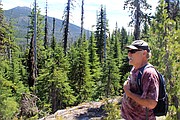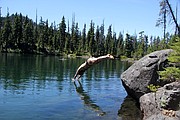'Lake bagging:'
OLALLIE LAKE SCENIC AREA, Ore. (AP) - We'd been trekking through the forest for half a mile, navigating by landmarks and occasional glances at the map, when a small body of water appeared through the trees.
"Ah-ha!" said Michael Donnelly, who was leading our trio. "I think this is 'Fish-Shaped Pond.'"
We stepped through a grove of pines, sweet-smelling in the sunlight, to discover a lake shaped like a perfect goldfish cracker. Off-trail and deep in the forest, I took a moment to appreciate the cliff-lined shore and groves of blue huckleberries before taking a deep breath and diving into the clear, blue-green waters of the day's second successful "lake bag."
Not a bad way to spend the afternoon.
The sport goes by the name "lake bagging," a quasi-competitive activity concocted by Donnelly and a few friends during the mid-1980s. The perfect pastime in Cascade Mountains during summer, the goal of lake bagging is visiting (and swimming in) as many mountain lakes as possible during the year's hottest months.
There is no official committee of the lake-bagging society - nor any grand commissioner to enforce official regulations - but there are a few rules to guide those exploring the countless blue dots scattered across Forest Service maps, both on the trail and off.
To wit:
1) Every named lake counts as one lake bag. Unnamed lakes, ponds or pools can count as well, but only if they're deep enough to go over your head.
2) To achieve a "full bag" that can be added to your total, you must totally immerse yourself in the water (go for a swim, and dunk your head).
3) Pack out any garbage you find at the lake, and leave no trace.
4) If you're going to swim in your birthday suit - in that most unabashed of fashions - make sure there's nobody around who might be offended by a naked buttock or two.
Beyond that, the only real guidance is to seek out lake-rich areas in Oregon, usually the Cascades, and follow Donnelly's example of simply going out and finding them.
"We started really checking out all the lakes, using a map and compass, and decided to have a competition to see who could swim in the most lakes in one year," said Donnelly, who lives in Salem and is former vice-president of the Oregon Natural Resources Council, along with co-founder of the Friends of Opal Creek and Breitenbush Cascades. "The most anyone has reported bagging in a single season is Chad Frazier's 58. I'd guess there are about 30 of us self-identified lake-baggers these days, and we're pretty much on our honor.
"The 'season' is usually around eight weeks and begins when the lakes get around 70 degrees. We all keep threatening to buy wet suits to extend the season, but so far, no one has."
The trick is finding a target-rich environment. And in that sense, few places are better than Olallie Lake Scenic Area.
Located northeast of Detroit off Breitenbush Highway 46, the Olallie backcounty is home to roughly 200 lakes both named and unnamed, on trail and off. The lakes sit around 5,000 feet, which means they're usually open for hiking by mid-June and have warmed to a comfortable temperature by mid-July.
I embarked on a lake-bagging expedition in the Olallie area last week, joining Donnelly and Alea Brager (another forest expert) for a trip that would include off-trail trekking and on-trail hiking to reach six lakes.
We began from a pullout along Forest Road 4220 near Olallie Lake, and with a map, compass and GPS device (mine) in tow, we navigated off-trail through a forest of cedar, hemlock and fir shining in the sunlight of a day that would reach 90 degrees.
Blue clusters of huckleberries made a tasty snack as we bushwhacked into the backcounty, tromping over boulders and getting stabbed by branches, to a starfish-shaped body of water known unofficially as "Nippon Lake." Already sweating from the day's heat, I waded into the rocky pool and splashed into the cool, clear water for the day's first swim.
"Remember," Donnelly said. "You have to dunk your whole body underwater for a full bag."
Not a problem.
We continued cross-county after drying off, making our way around a large landslide of boulders, to Fish-Shaped Pond (2) and then Finley Lake (3), where a high rock provided the ideal diving platform.
Each off-trail lake brought a new thrill of discovery, as though we'd found something new and pristine, the forest opening up to reveal a different body of water.
"It's such a blast because I feel like every footstep is the first one there, and I make sure to be as gentle as I can," said Brager, who works full time at Breitenbush Hot Springs Retreat and Conference Center. "You're working hard getting between these places, and there's a real satisfaction that comes with reaching the water."
The most spectacular moment came next.
After climbing a small ridge, we stepped out above the deep, sapphire water of Gifford Lake (4) shimmering in the basin below. Clear as a stained-glass window, it was the most scenic lake by far but also represented the beginning of a different sort of lake bagging.
A well-established trail circles the lake and leads from Gifford Lake to Lodgepole Trail, meaning our wilderness tromping would now be replaced by hiking.
Truth be told, I enjoy off-trail lake bagging most. The solitude and challenge of wandering into places unexplored, of discovering what that tiny blue dot on the map actually looks like is great fun.
At the same time, because the most spectacular lakes all have trails, trading excitement for beauty isn't such a bad thing. And we enjoyed plenty of that at Gifford Lake and just down the trail at Lower Lake (5), a 76-foot-deep chasm below the cone of Olallie Butte.
By the time we finished that fifth swim and reached Lower Lake Campground where we began following Road 4220 back toward the car, I was beginning to feel a bit soggy with the water of five different lakes soaking around in my brain.
The final lake was just off the road, a popular little spot known, ironically enough, as First Lake. And so, the 3.5-mile journey almost at an end, I took a deep breath and dove into the clear, blue-green waters of the final successful "lake bag."
Lake Bagging is an oddball sport that probably won't be featured on ESPN anytime soon, but the combination of navigating, hiking and swimming still makes a near-perfect way to enjoy the mountains during the year's hottest months.
"It's really just a great way for people to get out and experience nature," Donnelly said. "Every one of these lakes is special and different in its own way. For me, that first sight of the water through the trees is an almost transcendent experience."





